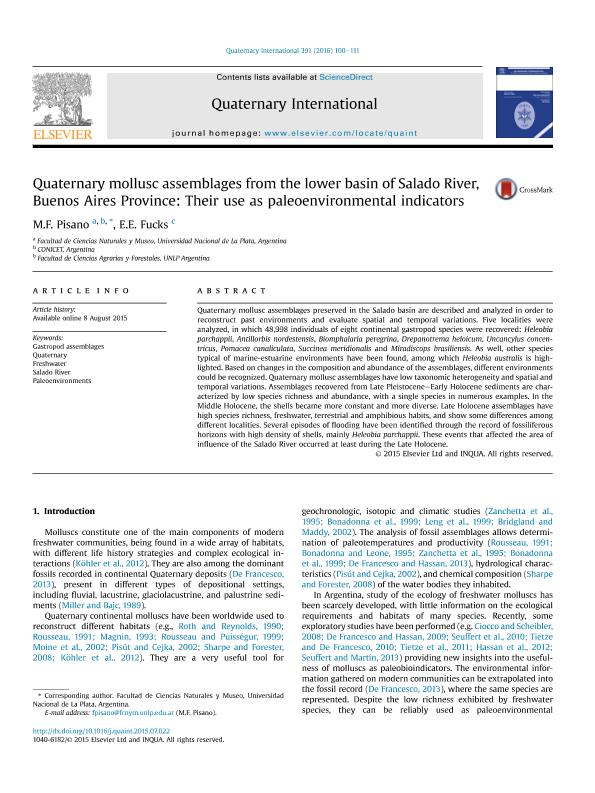Artículo
Quaternary mollusc assemblages from the lower basin of Salado River, Buenos Aires Province: Their use as paleoenvironmental indicators
Fecha de publicación:
01/2016
Editorial:
Pergamon-Elsevier Science Ltd
Revista:
Quaternary International
ISSN:
1040-6182
Idioma:
Inglés
Tipo de recurso:
Artículo publicado
Clasificación temática:
Resumen
Quaternary mollusc assemblages preserved in the Salado basin are described and analyzed in order to reconstruct past environments and evaluate spatial and temporal variations. Five localities were analyzed, in which 48,998 individuals of eight continental gastropod species were recovered: Heleobia parchappii, Antillorbis nordestensis, Biomphalaria peregrina, Drepanotrema heloicum, Uncancylus concentricus, Pomacea canaliculata, Succinea meridionalis and Miradiscops brasiliensis. As well, other species typical of marine-estuarine environments have been found, among which Heleobia australis is highlighted. Based on changes in the composition and abundance of the assemblages, different environments could be recognized. Quaternary mollusc assemblages have low taxonomic heterogeneity and spatial and temporal variations. Assemblages recovered from Late Pleistocene-Early Holocene sediments are characterized by low species richness and abundance, with a single species in numerous examples. In the Middle Holocene, the shells became more constant and more diverse. Late Holocene assemblages have high species richness, freshwater, terrestrial and amphibious habits, and show some differences among different localities. Several episodes of flooding have been identified through the record of fossiliferous horizons with high density of shells, mainly Heleobia parchappii. These events that affected the area of influence of the Salado River occurred at least during the Late Holocene.
Palabras clave:
Freshwater
,
Gastropod Assemblages
,
Paleoenvironments
,
Quaternary
,
Salado River
Archivos asociados
Licencia
Identificadores
Colecciones
Articulos(CCT - LA PLATA)
Articulos de CTRO.CIENTIFICO TECNOL.CONICET - LA PLATA
Articulos de CTRO.CIENTIFICO TECNOL.CONICET - LA PLATA
Citación
Pisano, Maria Florencia; Fucks, Enrique Eduardo; Quaternary mollusc assemblages from the lower basin of Salado River, Buenos Aires Province: Their use as paleoenvironmental indicators; Pergamon-Elsevier Science Ltd; Quaternary International; 391; 1-2016; 100-111
Compartir
Altmétricas




